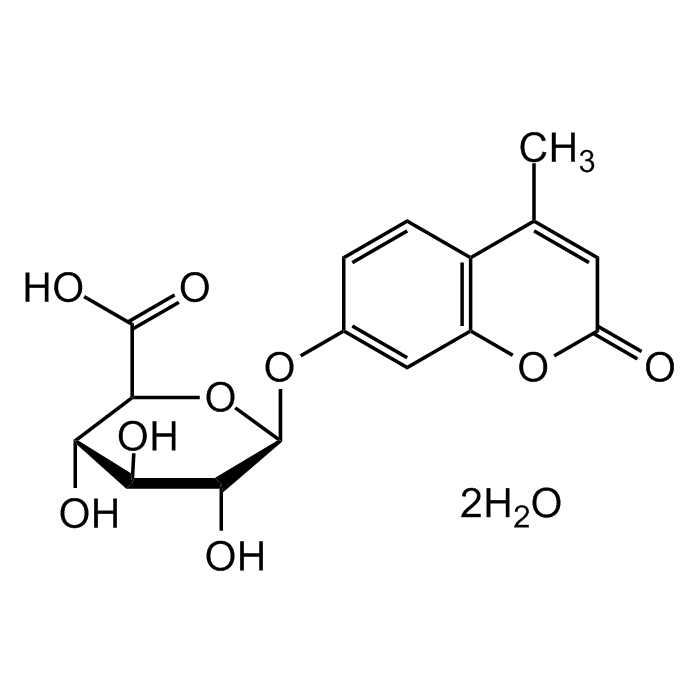Cookie Policy: This site uses cookies to improve your experience. You can find out more about our use of cookies in our Privacy Policy. By continuing to browse this site you agree to our use of cookies.
Chemodex
4-Methylumbelliferyl β-D-glucuronide dihydrate

| Product Details | |
|---|---|
| Synonyms | 4-Methylumbelliferyl-ß-D-glucopyranosiduronic acid; MUG; 4-MUG; 4-MU-glcUA; MUGlcU |
| Product Type | Chemical |
| Properties | |
| Formula |
C16H16O9 . xH2O |
| MW | 352.29 |
| CAS | 881005-91-0 | 6160-80-1 (anhydrous) |
| Purity Chemicals | ≥99% (HPLC) |
| Appearance | Colourless to white crystalline powder. |
| Solubility | Soluble in DMSO (50mg/ml) or water. |
| Identity | Determined by 1H-NMR. |
| Declaration | Manufactured by Chemodex. |
| Other Product Data |
Click here for Original Manufacturer Product Datasheet |
| InChi Key | ARQXEQLMMNGFDU-JHZZJYKESA-N |
| Smiles | O[C@@H]1[C@@H](O)[C@H](O)[C@@H](C(O)=O)O[C@H]1OC2=CC(OC(C=C3C)=O)=C3C=C2 |
| Shipping and Handling | |
| Shipping | AMBIENT |
| Short Term Storage | +4°C |
| Long Term Storage | +4°C |
| Handling Advice | Protect from light and moisture. |
| Use/Stability | Stable for at least 2 years after receipt when stored at +4°C. |
| Documents | |
| Product Specification Sheet | |
| Datasheet |
 Download PDF Download PDF |
4-Methylumbelliferyl-β-D-glucuronic acid dihydrate (MUG) is a non-fluorescent but fluorogenic β-glucuronidase substrate. Once cleaved, MUG yields blue fluorescence seen under UV light. The substrate is commonly used for rapid sensitive identification of Escherichia coli contamination and for detecting marker GUS gene expression in plants with high sensitivity. In microbiology it is a component in Violet Red Bile Agar and Lauryl Tryptose Broth, for the detection of coliform organisms in water, food and dairy products. Spectral Data. λEx/λEm= 360/450 nm (cleaved product). MUG both directly and indirectly inhibits hyaluronan (HA) synthesis.
(1) P.C. Feng & P.A. Hartman; Appl. Environ. Microbiol. 43, 1320 (1982) | (2) B. Sperker, et al.; J. Chromatogr. B Biomed. Sci. Appl. 685, 181 (1996) | (3) P. Villari, et al.; Lett. Appl. Microbiol. 24, 286 (1997) | (4) S. Fior, et al.; Plant Sci. 176, 130 (2009) | (5) N. Nagy, et al.; JBC 294, 7864 (2019)





